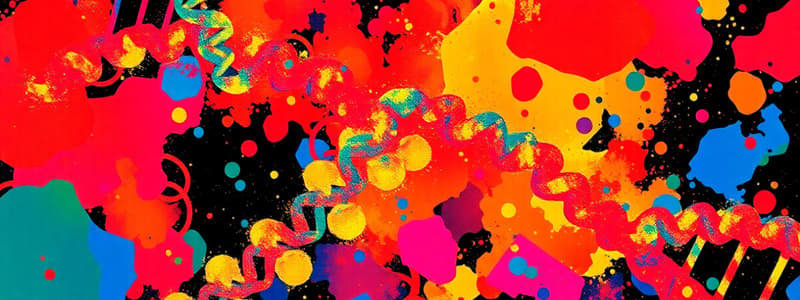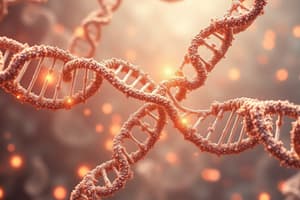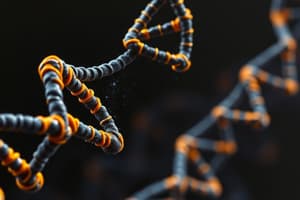Podcast
Questions and Answers
How do epigenetic modifications affect gene transcription?
How do epigenetic modifications affect gene transcription?
- By increasing the rate of DNA replication
- By permanently silencing all genes in the organism
- By altering chromatin structure and controlling factor accessibility (correct)
- By changing the nucleotide sequence of the genes
Which of the following is not an example of an epigenetic modification?
Which of the following is not an example of an epigenetic modification?
- Methylation of cytosine
- Methylation of Lysine and Arginine
- Acetylation of Lysine
- Deletion of a gene sequence (correct)
What does epigenetics refer to?
What does epigenetics refer to?
- Changes in the DNA base sequence
- Heritable changes in phenotype or gene expression not involving DNA sequence (correct)
- The process of DNA replication
- Permanent mutations in genes
What role do environmental stimuli play in epigenetics?
What role do environmental stimuli play in epigenetics?
Which of the following statements about histone modifications is true?
Which of the following statements about histone modifications is true?
Which base pairs with cytosine in DNA?
Which base pairs with cytosine in DNA?
What type of bond holds the base pairs together in the DNA double helix?
What type of bond holds the base pairs together in the DNA double helix?
Which base pairing occurs during gene transcription in RNA?
Which base pairing occurs during gene transcription in RNA?
Which statement about the stability of RNA is correct?
Which statement about the stability of RNA is correct?
What is the primary structural feature of the DNA double helix?
What is the primary structural feature of the DNA double helix?
Which base pairing has the strongest interaction in DNA?
Which base pairing has the strongest interaction in DNA?
How are nucleic acids defined in terms of size?
How are nucleic acids defined in terms of size?
Which of the following interactions enhances the stability of the DNA double helix?
Which of the following interactions enhances the stability of the DNA double helix?
What stabilizes the hydrophilic sugar-phosphate backbone of DNA?
What stabilizes the hydrophilic sugar-phosphate backbone of DNA?
What structural feature is unique to RNA compared to DNA?
What structural feature is unique to RNA compared to DNA?
What is the composition of a nucleotide?
What is the composition of a nucleotide?
Which nitrogenous base is found in RNA but not in DNA?
Which nitrogenous base is found in RNA but not in DNA?
Which pairing of nucleotide bases is incorrect?
Which pairing of nucleotide bases is incorrect?
What type of bond holds the DNA double helix together?
What type of bond holds the DNA double helix together?
Which component of the nucleotide varies between DNA and RNA?
Which component of the nucleotide varies between DNA and RNA?
Which of these molecules is a nucleoside?
Which of these molecules is a nucleoside?
What kind of nucleotides link to form DNA?
What kind of nucleotides link to form DNA?
During gene transcription, which base pairs with adenine?
During gene transcription, which base pairs with adenine?
Which of the following correctly describes the structure of ATP?
Which of the following correctly describes the structure of ATP?
In nucleotides, what connects the nitrogenous base to the sugar?
In nucleotides, what connects the nitrogenous base to the sugar?
Which of the following statements about pyrimidines is true?
Which of the following statements about pyrimidines is true?
Which pair of bases is correctly matched with their corresponding structure?
Which pair of bases is correctly matched with their corresponding structure?
What is the role of the phosphate group in a nucleotide?
What is the role of the phosphate group in a nucleotide?
What is the estimated time for genome replication in a cell?
What is the estimated time for genome replication in a cell?
Why is multiple origins of replication necessary for genome replication?
Why is multiple origins of replication necessary for genome replication?
What structure forms as DNA is replicated at multiple sites?
What structure forms as DNA is replicated at multiple sites?
Which histone tetramers remain intact after DNA synthesis?
Which histone tetramers remain intact after DNA synthesis?
What happens to histones during DNA replication?
What happens to histones during DNA replication?
What is the role of new H3/H4 tetramer cores during replication?
What is the role of new H3/H4 tetramer cores during replication?
What is the result of having replication forks proceeding in opposite directions?
What is the result of having replication forks proceeding in opposite directions?
What occurs immediately after the removal of histones in front of the replication bubble?
What occurs immediately after the removal of histones in front of the replication bubble?
What is the starting point for DNA replication?
What is the starting point for DNA replication?
During DNA replication, which polymerase initially binds to the strand at the primer site?
During DNA replication, which polymerase initially binds to the strand at the primer site?
Which DNA polymerases are primarily involved in proofreading during DNA replication?
Which DNA polymerases are primarily involved in proofreading during DNA replication?
How many RNA primers are needed for the lagging strand during replication?
How many RNA primers are needed for the lagging strand during replication?
What direction does DNA replication proceed in?
What direction does DNA replication proceed in?
What results from the action of DNA ligase during DNA replication?
What results from the action of DNA ligase during DNA replication?
During what step are RNA primers degraded and filled in during DNA replication?
During what step are RNA primers degraded and filled in during DNA replication?
What is the orientation of the leading strand during DNA replication?
What is the orientation of the leading strand during DNA replication?
Why can't replication originate from a single site on each chromosome?
Why can't replication originate from a single site on each chromosome?
What are Okazaki fragments associated with?
What are Okazaki fragments associated with?
What are enzymes?
What are enzymes?
Why are enzymes important?
Why are enzymes important?
How do enzymes work?
How do enzymes work?
Match the types of enzymes with the reactions they catalyze:
Match the types of enzymes with the reactions they catalyze:
What are coenzymes?
What are coenzymes?
What are cofactors?
What are cofactors?
What factors affect enzyme function?
What factors affect enzyme function?
What is Medium acyl-coA dehydrogenase deficiency (MCADD)?
What is Medium acyl-coA dehydrogenase deficiency (MCADD)?
How do enzymes act as drug targets?
How do enzymes act as drug targets?
Flashcards are hidden until you start studying
Study Notes
DNA Replication
- DNA is a double-stranded helix composed of nucleotides.
- Nucleotides have three components: a nitrogenous base, a pentose sugar, and a phosphate group.
- In DNA, the pentose sugar is deoxyribose.
- Ribose is present in RNA.
- Nitrogenous bases are either purines (Adenine, Guanine) or pyrimidines (Cytosine, Thymine, Uracil).
- Thymine is present in DNA, Uracil in RNA.
- DNA replication involves the production of two identical DNA strands from one original strand.
- The bases of complementary strands of DNA are held together by hydrogen bonds.
- Cytosine pairs with Guanine through three hydrogen bonds.
- Thymine pairs with Adenine through two hydrogen bonds.
- This pairing is crucial for the stability of the DNA double helix.
- The hydrophobic bases are located in the center of the helix, away from water.
- This core is stabilized by hydrogen bonds between the bases.
- The sugar phosphate backbone is on the outside and is stabilized by electrostatic and hydrogen bonding interactions with water.
- The DNA double helix is also stabilized by weaker Van der Waals forces between the stacked bases
- The replication process is bidirectional, meaning it occurs simultaneously from both ends of the DNA molecule.
- The two strands are oriented in opposite directions, one strand oriented 3' to 5' direction, also known as the leading strand, and the other oriented 5' to 3' direction, also known as the lagging strand.
- Each strand is replicated by different processes due to this directional difference
- The leading strand is replicated continuously in the 5' to 3' direction.
- The lagging strand is replicated discontinuously, as Okazaki fragments.
- DNA polymerase α initiates replication by binding to the strand at the site of the primer and adds new complementary base pairs.
- DNA polymerase ε takes over elongation, extending the primer by about 20 base pairs.
- DNA polymerase ε and δ have proofreading activity, preventing the incorporation of incorrect nucleotides.
- RNA primers initiate replication on the lagging strand.
- DNA polymerase δ fills the gaps between the RNA primers, creating Okazaki fragments.
- RNAase H degrades the RNA primers.
- DNA ligase joins the fragments, creating a continuous DNA strand.
- Replication occurs at "multiple origins of replication" on the chromosome.
- Multiple origins of replication ensure efficient replication and speed up the entire process.
- DNA replication is accomplished in approximately 8 hours.
Epigenetic Inheritance
- Epigenetics refers to heritable changes in cell behaviour or gene expression caused by mechanisms other than changes in the DNA sequence.
- Examples of epigenetic modifications include histone modifications and DNA modifications.
- These modifications alter the structure of chromatin, influencing the accessibility of transcription factors and co-activators.
- Environmental factors like smoking and nutrition can influence epigenetic marks.
- Epigenetic inheritance allows for environmental factors to be passed down genetically.
Histone Inheritance
- H3/H4 tetramer cores remain intact during replication.
- New H3/H4 tetramer cores bind to the newly synthesized DNA, followed by H2A/H2B dimers.
What are enzymes?
- Enzymes are biological catalysts.
- They speed up chemical reactions in living organisms.
Why are enzymes important?
- They are essential for life.
- They facilitate thousands of metabolic reactions in the body.
How do enzymes work?
- Enzymes work by lowering the activation energy of a reaction - the energy required to get a reaction going.
- They do this by providing an alternative reaction pathway with a lower activation energy.
- They form a complex with the substrate molecule, which brings the reacting molecules together.
Types of enzymes
- Oxidoreductases: Catalyze oxidation/reduction reactions. They often use reducing equivalents.
- Isomerases: Catalyze isomerisation or rearrangement reactions. For example, glucose to fructose.
- Transferases: Catalyze the transfer of functional groups. Example functional groups include methyl, phosphoryl, sulfate, sugars.
- Hydrolases: Catalyze bond cleavage via reaction with water.
- Lyases: Catalyze addition and elimination reactions. Cleave C-O, C-S and C-C bonds.
- Ligases: Catalyze covalent linkage of two substrates together. For example, DNA bases, Ubiquitin onto peptide side chains.
Coenzymes and cofactors
- Coenzymes are molecules that act as carriers of electrons or chemical groups. They are often derived from vitamins. NADPH and AcoA are examples.
- Cofactors are non-protein molecules, including inorganic ions. They change the structure of an active site in the enzyme, facilitating enzymatic activity. Examples include metal ions.
Regulation of activity
- Enzymes can be regulated in a number of ways.
- Substrate concentration: Increasing the concentration of the substrate generally results in increased enzyme activity, until the enzyme is saturated.
- Inhibition: Inhibitor molecules can bind to the enzyme and inhibit its activity.
How else can we regulate enzyme activity?
- Gene expression: The amount of enzyme produced can be regulated at the level of gene expression.
- Proenzyme activation: Some enzymes are produced as inactive precursors called proenzymes.
- Protein stability: The stability of an enzyme can affect its activity.
- Localization: The location of an enzyme within the cell can influence its activity.
Factors affecting enzyme function
- Temperature: Enzymes have an optimal temperature at which they function best.
- pH: Each enzyme has an optimal pH range at which it functions best.
- Substrate concentration: Increasing the concentration of the substrate generally results in increased enzyme activity.
- Product concentration: Increasing the concentration of product generally results in decreased enzyme activity.
Enzymes in medicine - metabolic diseases
- Medium acyl-coA dehydrogenase deficiency (MCADD): This is an inborn error of metabolism that causes a defect in beta-oxidation of fatty acids.
- The defect affects enzymes that react with different length chains, specifically those with a chain length of 4-12 carbons long. The affected enzymes have reduced or lost activity.
Enzymes in medicine - drug metabolism
- Enzymes can act as activators of pro-drugs: Pro-drugs are inactive drugs that are converted to active drugs in the body.
- Example of a pro-drug: ICT2588
- Enzymes can modulate the toxicity and drug action: Enzymes can influence the way drugs are metabolized and their effectiveness.
Enzymes in medicine - drug targets
- Example of a drug target:
- Gout: A condition that causes pain and inflammation in the joints due to a build-up of uric acid crystals. One way to treat gout is by inhibiting the enzyme xanthine oxidase, which is involved in the production of uric acid.
Studying That Suits You
Use AI to generate personalized quizzes and flashcards to suit your learning preferences.




